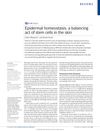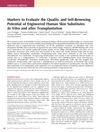43 citations
,
September 2009 in “Stem Cells”  1039 citations
,
February 2009 in “Nature Reviews Molecular Cell Biology”
1039 citations
,
February 2009 in “Nature Reviews Molecular Cell Biology” Skin stem cells are crucial for maintaining and repairing the skin and hair, using a complex mix of signals to do so.
 120 citations
,
August 2008 in “The journal of investigative dermatology/Journal of investigative dermatology”
120 citations
,
August 2008 in “The journal of investigative dermatology/Journal of investigative dermatology” Cytokeratin 19 and cytokeratin 15 are key markers for monitoring the quality and self-renewing potential of engineered skin.
 34 citations
,
June 2008 in “In vitro cellular & developmental biology. Animal”
34 citations
,
June 2008 in “In vitro cellular & developmental biology. Animal” Scientists created a long-lasting stem cell line from human hair that can turn into different skin and hair cell types.
1398 citations
,
May 2008 in “Histochemistry and Cell Biology” Keratins are crucial for cell stability, wound healing, and cancer diagnosis.
45 citations
,
December 2007 in “The FASEB journal” There are two types of stem cells in rodent hair follicles, each with different keratin proteins.
9 citations
,
July 2007 in “Journal of Investigative Dermatology” Claudin expression changes help the skin respond to injury.
 788 citations
,
February 2007 in “Nature”
788 citations
,
February 2007 in “Nature” The document concludes that skin stem cells are important for hair growth and wound healing, and could be used in regenerative medicine.
63 citations
,
April 2005 in “Mechanisms of development” Mice with too much Claudin-6 have skin barrier problems and abnormal hair growth.
233 citations
,
October 2004 in “Differentiation” The study identified markers for distinguishing stem cell, transit amplifying, and differentiating compartments in adult human skin using flow cytometry. Epidermal cells with high α6 integrin and low CD71 (α6briCD71dim) were identified as stem cells, comprising 2%-5% of the K14bri fraction, characterized by quiescence, small size, and high clonogenic capacity. In contrast, cells with high levels of both α6 integrin and CD71 (α6briCD71bri) were identified as transit amplifying cells, actively cycling with intermediate clonogenic capacity. Differentiating cells were marked by low α6 integrin (α6dim) and poor clonogenic efficiency. The study concluded that stem and transient amplifying cells were located in the deep rete ridges, while differentiating cells were in the shallow rete ridges.
387 citations
,
November 2003 in “Journal of Investigative Dermatology” The study investigated the keratin 15 (K15) promoter's role in targeting epithelial stem cells in the hair follicle bulge using K15/lacZ transgenic mice. It was found that K15 expression was age-dependent and correlated with keratinocyte differentiation levels, with strong expression in less differentiated cells in the neonatal epidermis and adult bulge area. The K15 promoter specifically targeted bulge cells, which are thought to be stem cells, throughout all hair cycle stages, with 92%±3% of K15/lacZ-positive cells being label-retaining, indicating a quiescent stem cell phenotype. This research provided a valuable tool for further studies on hair follicle biology, wound healing, and carcinogenesis.
198 citations
,
March 1999 in “Journal of Investigative Dermatology” 46 citations
,
November 1998 in “Experimental Cell Research” 318 citations
,
October 1998 in “The Journal of Cell Biology” Keratin 17 is important for skin development and may help define skin cell types.
238 citations
,
October 1994 in “Current opinion in genetics & development” The document concludes that recent research has improved understanding of skin diseases and the balance between cell growth and differentiation in the epidermis.
198 citations
,
November 1989 in “The Journal of Cell Biology” The study examined the expression of keratin K14 in human skin, particularly in the epidermis and hair follicles, using monospecific antisera and cRNA probes. It was found that K14 expression and filament organization differed significantly between the hair follicle and epidermis. In the outer root sheath (ORS) cells, which are mitotically active, K14 expression was low, and keratin filaments were fewer and more loosely organized compared to basal epidermal cells. As ORS cells differentiated, they increased K14 expression and formed denser keratin bundles. In contrast, matrix cells, which can differentiate into the inner root sheath, cuticle, and hair shaft, did not express K14 or form keratin filaments. Instead, they produced hair-specific keratins and dense filament bundles without inducing K14 expression. The study suggested that the patterns of K14 expression and filament organization in skin epithelial cells were linked to their pluripotency and highlighted the distinct differentiation programs of hair follicles compared to other stratified squamous epithelia.




